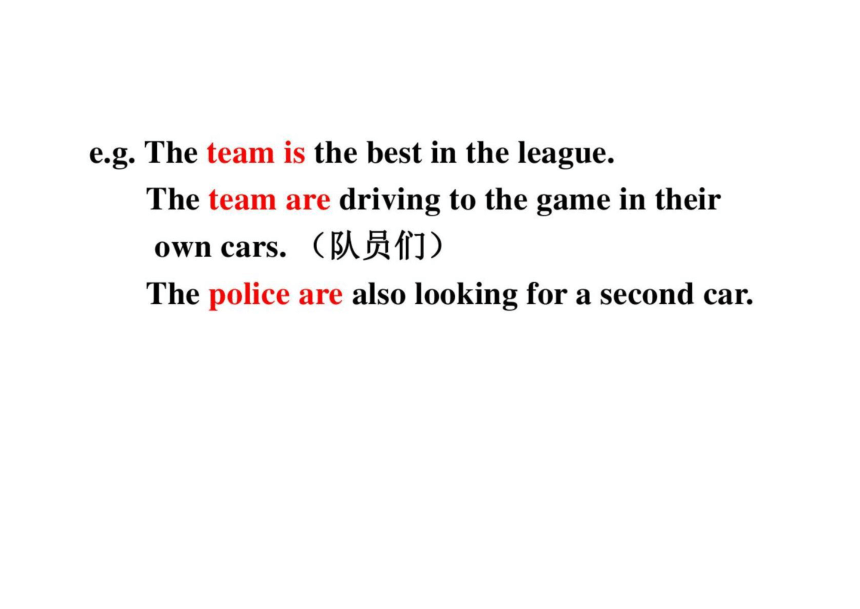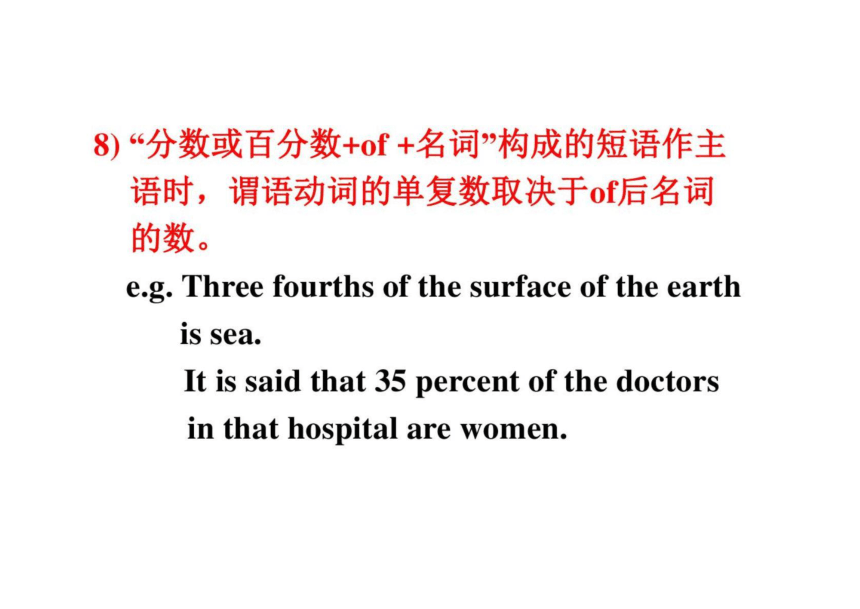备战2022年高考英语二轮复习专题19-主谓一致课件(40张)
文档属性
| 名称 | 备战2022年高考英语二轮复习专题19-主谓一致课件(40张) |  | |
| 格式 | zip | ||
| 文件大小 | 4.7MB | ||
| 资源类型 | 教案 | ||
| 版本资源 | 通用版 | ||
| 科目 | 英语 | ||
| 更新时间 | 2021-12-31 19:49:39 | ||
图片预览












文档简介
(共40张PPT)
主谓一致
主谓一致原则
主谓一致是指主语和谓语在人称和数上保
持一致。一般遵循下列原则:
1.语法一致原则:主语和谓语在人称和数上
致。主语是单数形式,谓语动词也采用单
数形式;主语是复数形式,谓语动词也采
用复数形式。
2.意义一致原则:谓语的单复数取决于主语
的意义。有时主语形式上为单数,但意义
上却是复数,那么谓语根据意义也用复数
形式;有时主语形式上为复数,但意义上
却是单数,那么谓语根据意义应用单数形
式。
3就近一致原则:谓语动词的形式与邻近
的主语在人称和数上一致。如 There be;
either….or…; neither….nor…; not only∴
but also…等。
二、主谓一致的具体应用
1.名词作主语
1)集体名词作主语,如果表示整体概念,谓
语动词用单数形式;如果强调个体,谓语
动词用复数形式。常见的这类名词有:
army, audience, class, family, team, crowd,
staff, committee, enemy, government,
population等。
有些集合名词如catt, people, police等,通
常看作复数,谓语动词必须用复数。
e.g. The team is the best in the league.
The team are driving to the game in their
own cars.(队员们)
The police are also looking for a second car.
2)单复数同形的名词作主语,应根据其意义来
决定谓语形式。常见的这类名词
A: deer, fish, sheep Chinese, Japanese
means, works(工厂)等。
e.g. Every possible means has been tried, but
none of them worked
All possible means are considered, but
none can handle the problem.
3)表示单数概念的复形名词,(如:学科、
机构、书名、剧名)等作主语,谓语动
词通常用单数。
e.g. Ethics is the study of the principles of
right and wrong in human conduct
The United states was founded in
1776
主谓一致
主谓一致原则
主谓一致是指主语和谓语在人称和数上保
持一致。一般遵循下列原则:
1.语法一致原则:主语和谓语在人称和数上
致。主语是单数形式,谓语动词也采用单
数形式;主语是复数形式,谓语动词也采
用复数形式。
2.意义一致原则:谓语的单复数取决于主语
的意义。有时主语形式上为单数,但意义
上却是复数,那么谓语根据意义也用复数
形式;有时主语形式上为复数,但意义上
却是单数,那么谓语根据意义应用单数形
式。
3就近一致原则:谓语动词的形式与邻近
的主语在人称和数上一致。如 There be;
either….or…; neither….nor…; not only∴
but also…等。
二、主谓一致的具体应用
1.名词作主语
1)集体名词作主语,如果表示整体概念,谓
语动词用单数形式;如果强调个体,谓语
动词用复数形式。常见的这类名词有:
army, audience, class, family, team, crowd,
staff, committee, enemy, government,
population等。
有些集合名词如catt, people, police等,通
常看作复数,谓语动词必须用复数。
e.g. The team is the best in the league.
The team are driving to the game in their
own cars.(队员们)
The police are also looking for a second car.
2)单复数同形的名词作主语,应根据其意义来
决定谓语形式。常见的这类名词
A: deer, fish, sheep Chinese, Japanese
means, works(工厂)等。
e.g. Every possible means has been tried, but
none of them worked
All possible means are considered, but
none can handle the problem.
3)表示单数概念的复形名词,(如:学科、
机构、书名、剧名)等作主语,谓语动
词通常用单数。
e.g. Ethics is the study of the principles of
right and wrong in human conduct
The United states was founded in
1776
